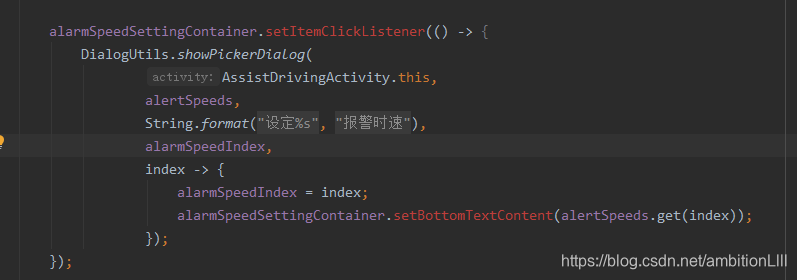这边引入了GitHub上的第三方控件。
除了第五步的点击事件源码需要根据实际情况再进行修改,其余的代码均已调通,在后面的项目中可直接复用。
一、需求UI图
以前的UI图找不到了,直接手绘了一个UI图如下。
可知这个弹窗中,包含一个标题TextView,一个关闭按钮ImageView,两个Button表示确定和取消,中间还需要一个可以拖动的选项条,这边使用了GitHub上一个第三方WheelView。
第三方WheelView的使用链接GitHub
说到这边正好总结一下GitHub上第三方控件的使用。
以本项目中的pickerview为例:
输入pickerview搜索,筛选java,sort选择Most stars,选择第一个,打开查看,阅读使用文档等。

二、代码设计步骤
(1)一个drawable:dialog_background,作为背景被几个弹窗复用。
(2)一个layout:picker_dialog.xml
(3)PickerDialogFragment.java
(4)DialogUtils工具类定义showPickerDialog方法
(5)Activity中设置点击事件弹出弹窗,使用showPickerDialog方法进行复用。
三、源码
(1)dialog_background.xml
<?xml version="1.0" encoding="utf-8"?>
<shape xmlns:android="http://schemas.android.com/apk/res/android">
<corners android:radius="15dp" />
<solid android:color="@color/cardview_shadow_start_color" />
</shape>
(2)一个layout:picker_dialog.xml
由于要导入一个第三方滑动选项条控件WheelView,我们需要先在build.gradle中导入依赖:
compile 'com.contrarywind:Android-PickerView:4.1.9'
导入后,layout中就可以直接使用WheelView控件了。
该第三方控件具体的使用方法可以参考上面已经给出的链接。
接下来就是picker_dialog.xml的代码:
<?xml version="1.0" encoding="utf-8"?>
<androidx.constraintlayout.widget.ConstraintLayout
xmlns:android="http://schemas.android.com/apk/res/android"
xmlns:app="http://schemas.android.com/apk/res-auto"
android:layout_width="match_parent"
android:layout_height="match_parent"
android:background="@drawable/dialog_background">
<ImageView
android:id="@+id/close"
android:layout_width="40dp"
android:layout_height="40dp"
android:layout_marginStart="20dp"
android:layout_marginTop="20dp"
app:layout_constraintStart_toStartOf="parent"
app:layout_constraintTop_toTopOf="parent"
app:srcCompat="@drawable/close" />
<TextView
android:id="@+id/title"
android:layout_width="wrap_content"
android:layout_height="wrap_content"
android:layout_marginEnd="90dp"
android:layout_marginStart="30dp"
android:text="设定报警时速"
android:textSize="26sp"
app:layout_constraintBottom_toBottomOf="@+id/close"
app:layout_constraintEnd_toEndOf="parent"
app:layout_constraintStart_toEndOf="@+id/close"
app:layout_constraintTop_toTopOf="@+id/close" />
<LinearLayout
android:layout_width="0dp"
android:layout_height="0dp"
android:orientation="vertical"
app:layout_constraintBottom_toTopOf="@+id/sure"
app:layout_constraintEnd_toEndOf="parent"
app:layout_constraintStart_toStartOf="parent"
app:layout_constraintTop_toBottomOf="@+id/title">
<com.contrarywind.view.WheelView
android:id="@+id/options"
android:layout_width="match_parent"
android:layout_height="match_parent" />
</LinearLayout>
<Button
android:id="@+id/sure"
android:layout_width="wrap_content"
android:layout_height="wrap_content"
android:layout_marginBottom="8dp"
android:text="确定"
app:layout_constraintBottom_toBottomOf="parent"
app:layout_constraintEnd_toStartOf="@+id/guideline"
app:layout_constraintStart_toStartOf="parent" />
<androidx.constraintlayout.widget.Guideline
android:id="@+id/guideline"
android:layout_width="wrap_content"
android:layout_height="wrap_content"
android:orientation="vertical"
app:layout_constraintGuide_percent="0.5" />
<Button
android:id="@+id/cancel"
android:layout_width="wrap_content"
android:layout_height="wrap_content"
android:layout_marginBottom="8dp"
android:text="取消"
app:layout_constraintBottom_toBottomOf="parent"
app:layout_constraintEnd_toEndOf="parent"
app:layout_constraintStart_toStartOf="@+id/guideline" />
</androidx.constraintlayout.widget.ConstraintLayout>
(3)PickerDialogFragment.java:
public class PickerDialogFragment extends DialogFragment {
List<String> items;
PickerDialogFragmentListener pickerDialogFragmentListener;
int index;
@Nullable
@Override
public View onCreateView(LayoutInflater inflater,
@Nullable ViewGroup container, @Nullable Bundle savedInstanceState) {
getDialog().requestWindowFeature(Window.FEATURE_NO_TITLE);
View view = inflater.inflate(R.layout.picker_dialog, container, false);
Bundle bundle = getArguments();
items = bundle.getStringArrayList("data");
String title = bundle.getString("title");
index = bundle.getInt("index");
ImageView close = view.findViewById(R.id.close);
TextView titleText = view.findViewById(R.id.title);
TextView sure = view.findViewById(R.id.sure);
TextView cancel = view.findViewById(R.id.cancel);
titleText.setText(title);
sure.setOnClickListener(v -> {
if (pickerDialogFragmentListener != null) {
pickerDialogFragmentListener.getData(index);
}
getDialog().cancel();
});
cancel.setOnClickListener(v -> getDialog().cancel());
close.setOnClickListener(v -> getDialog().cancel());
initWheelView(view);
return view;
}
private void initWheelView(View view) {
WheelView options = view.findViewById(R.id.options);
options.setCyclic(false);
options.setTextColorCenter(Color.WHITE);
options.setTextSize(26);
options.setAdapter(new ArrayWheelAdapter(items));
options.setOnItemSelectedListener(index -> this.index = index);
options.setCurrentItem(index);
}
@Override
public void onStart() {
super.onStart();
Dialog dialog = getDialog();
if (dialog != null ) {
DisplayMetrics dm = new DisplayMetrics();
getActivity().getWindowManager().getDefaultDisplay().getMetrics(dm);
int height = ViewGroup.LayoutParams.MATCH_PARENT;
dialog.getWindow().setLayout((int) (dm.widthPixels * 0.5), height);
dialog.getWindow().setBackgroundDrawable(new ColorDrawable(Color.TRANSPARENT));
}
}
public void setPickerDialogFragmentListener(PickerDialogFragmentListener pickerDialogFragmentListener) {
this.pickerDialogFragmentListener = pickerDialogFragmentListener;
}
public void setItems(List<String> items) {
this.items = items;
}
public void setIndex(int index) {
this.index = index;
}
public interface PickerDialogFragmentListener {
void getData(int index);
}
}
(4)DialogUtils工具类定义showPickerDialog方法
方法如下:
public static void showPickerDialog(
AppCompatActivity activity,
ArrayList<String> data,
String title,
int currentIndex,
PickerDialogFragment.PickerDialogFragmentListener listener) {
PickerDialogFragment fragment = new PickerDialogFragment();
Bundle bundle = new Bundle();
bundle.putStringArrayList("data", data);
bundle.putString("title", title);
bundle.putInt("index", currentIndex);
fragment.setArguments(bundle);
fragment.setPickerDialogFragmentListener(listener);
fragment.show(activity.getSupportFragmentManager(), "fragment");
}
(5)Activity中设置点击事件弹出弹窗,使用showPickerDialog方法进行复用。
首先在arrays.xml中定义我们WheelView中需要的数据:
<?xml version="1.0" encoding="utf-8"?>
<resources>
<array name="alertSpeeds">
<item>30</item>
<item>35</item>
<item>40</item>
<item>45</item>
<item>50</item>
<item>55</item>
<item>60</item>
<item>65</item>
<item>70</item>
<item>75</item>
<item>80</item>
<item>85</item>
<item>90</item>
<item>95</item>
<item>100</item>
<item>105</item>
<item>110</item>
<item>115</item>
<item>120</item>
<item>125</item>
<item>130</item>
<item>135</item>
<item>140</item>
<item>145</item>
<item>150</item>
<item>155</item>
<item>160</item>
<item>165</item>
<item>170</item>
<item>175</item>
<item>180</item>
<item>185</item>
<item>190</item>
<item>195</item>
<item>200</item>
<item>205</item>
<item>210</item>
<item>215</item>
<item>220</item>
</array>
</resources>
然后再回到Activity中,
先声明一个ArrayList:
ArrayList<String> alertSpeeds;
然后在代码中把数据传入这个ArrayList:
alertSpeeds = new ArrayList<>();
TypedArray alertSpeedsTypedArray = getResources().obtainTypedArray(R.array.alertSpeeds);
for (int i = 0; i < alertSpeedsTypedArray.length(); i++) {
alertSpeeds.add(alertSpeedsTypedArray.getInt(i, 0) + "km/h");
}
alertSpeedsTypedArray.recycle();
接着就是点击事件的实现,调用ShowPickerDialog方法:

上图代码如下:
alarmSpeedSettingContainer.setItemClickListener(() -> {
DialogUtils.showPickerDialog(
AssistDrivingActivity.this,
alertSpeeds,
String.format(getString(R.string.setting_dialog_title), getString(R.string.alarm_speed)),
alarmSpeedIndex,
index -> {
alarmSpeedIndex = index;
alarmSpeedSettingContainer.setBottomTextContent(alertSpeeds.get(index));
});
});